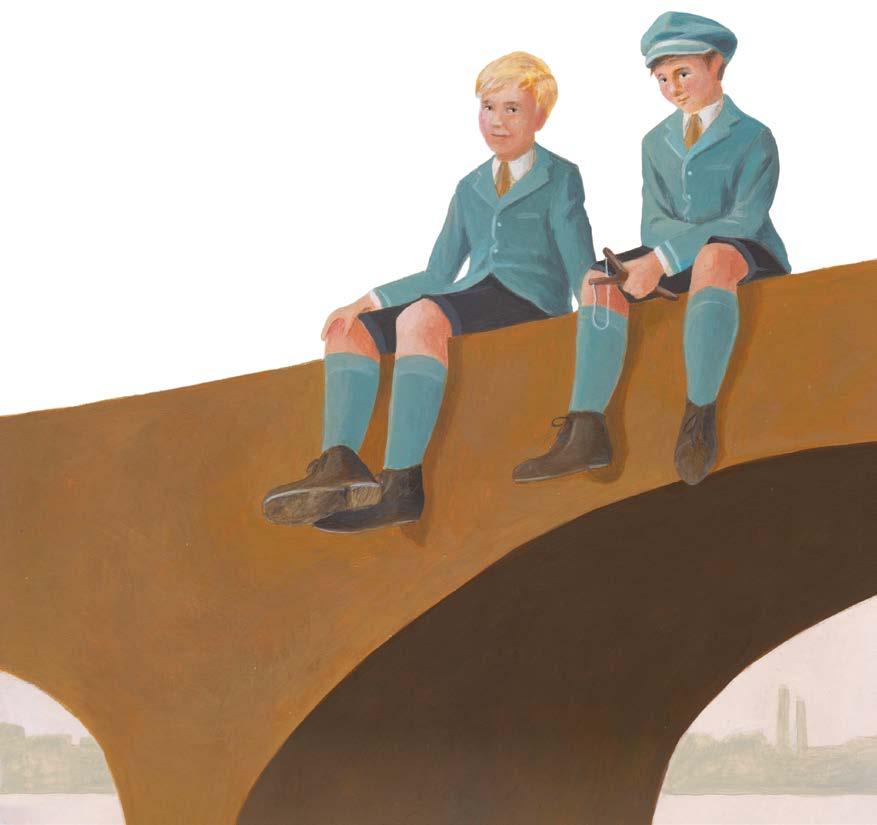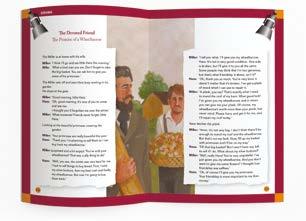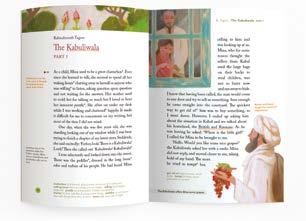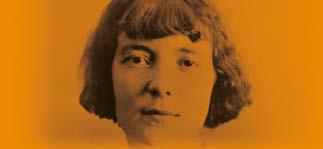Katherine Mansfield
James Joyce Oscar Wilde
Rabindranath
Mark Twain

Katherine Mansfield
James Joyce Oscar Wilde
Rabindranath
Mark Twain

Information about the author, the story and the historical period.
Brief descriptions of the main characters.

The text with cultural details, brief summaries and glossary.






Pre-reading activities.
A wide variety of activities covering Cambridge Exam Certificates, State exams, 21st Century Skills and 2030 Agenda topics.
A final test to check what you remember.
A transcript of one of the most important scenes from the story to act out together in class.
Sir Arthur Conan Doyle The Sign of the Four
E. Gaskell, K. Chopin, K. Mansfield, V. Woolf, E.Wharton Portraits of Women
Robert Louis Stevenson The Strange Case of Dr Jekyll and Mr Hyde
Geoffrey Chaucer The Canterbury Tales
Jane Austen Pride and Prejudice
Lewis Carroll Alice in Wonderland
Oscar Wilde The Canterville Ghost
H.G. Wells, G. Orwell, E.A. Poe, S.O. Jewett, V. Woolf One Planet, One Goal
Mary Shelley Frankenstein
George Orwell Animal Farm
K. Mansfield, J. Joyce, O. Wilde, R. Tagore, M. Twain Tales of Friendship
Charlotte Brontë Jane Eyre
Oscar Wilde The Picture of Dorian Gray
H.G. Wells The Time Machine
Retold and Activities Alex Peet
Anthology Selection Silvia Rizzi
Series Editors Paola Accattoli, Grazia Ancillani
Art Director Daniele Garbuglia
Graphic Design Emilia Coari
Production Manager Francesco Capitano
Photo Credits Shutterstock
© 2023 ELi, Gruppo editoriale ELi
23.83.267.0
ENG016.01
ISBN 978-88-536-3978-3
www.gruppoeli.it







The Modernist movement (late 19th to mid-20th century) was an experimental style of writing. Writers used non-linear narrative and interior monologues to show characters’ emotions.
Born Kathleen Beauchamp, Katherine Mansfield is considered by many to be New Zealand’s most important and famous writer. She was a journalist, poet, essayist and author whose work in the Modernist movement led to her being celebrated across the world and translated into twenty-five languages.

Katherine Mansfield was born on 14th October 1888 in Wellington, New Zealand, into a wealthy and prominent* family. Her father, Sir Harold Beauchamp, was a businessman and philanthropist who became chairman* of the Bank of New Zealand and was knighted* in 1923. Her mother, Lady Annie Beauchamp, was related to the New Zealand Prime Minister by marriage. Katherine had two older sisters and a younger brother. The three sisters attended school in the suburb* of Karori before going to Wellington Girls College and later the exclusive Fitzherbert Terrace School. It was there that Katherine met Maata, who was descended from a Maori tribal leader. Maata became her friend, muse* and later lover.
In her diaries, Mansfield criticised the treatment of the Maori people and in her later stories, such as How Pearl Button Was Kidnapped, portrayed Maori characters positively. Mansfield’s first published story was His Little Friend, which appeared in a magazine in 1900, just before her twelfth birthday.

prominent (adj) well-known chairman (n) president or person in charge of a company or committee knight (v) by a king or queen, give a title to someone for their service suburb (n) the residential area surrounding a city muse (n) artistic inspiration

In 1903, at the age of 19, Katherine moved to London. Together with her sisters, she attended Queens College and thought she would become a professional cellist*. However, she turned her attention to writing, started contributing to the college newspaper regularly and became its editor. She was especially interested in French Symbolists and Oscar Wilde.
While at college, she met Ida Baker, who remained a friend throughout her life.
Mansfield travelled in Europe from 1903 to 1906, particularly in Germany and Belgium. After finishing school, she returned to New Zealand, where she wrote a number of short stories and first used her mother’s maiden* name as a pseudonym – Kathleen Beauchamp became Katherine Mansfield. However, life in New Zealand was too limiting for Mansfield and, in 1908, she returned to London, where she led a Bohemian lifestyle and became friends with D.H. Lawrence and Virginia Woolf.

As a young teenager, in 1902, Mansfield fell in love with Arnold Trowell, who was the son of her cello teacher. However, her feelings were not reciprocated*. Her first relationship was with Maata Mahapukua, who she wrote about in several short stories.
Heartbroken after Maata’s marriage in 1907, she began a relationship with Edith Kathleen Bendall and later with Arnold Trowell’s brother, Garnet, becoming pregnant
Symbolism was a late 19th century movement where emotions were expressed through the symbolic value of language.
Bohemians were intellectuals, artists, musicians, writers whose lives centred around these art forms and who did not believe in the traditional lifestyle of the time.
D.H. Lawrence and Virginia Woolf were two famous 20th century Modernist British writers.
in 1909. The couple broke up because his family did not approve. Mansfield hastily* married George Bowden, who was eleven years older than her, but left him on their wedding night. Her mother was furious about the failure of the marriage, which she blamed on Katherine’s friendship with Ida Baker, and sent her daughter to Bavaria in Germany. Whilst there, she lost the baby. It is unclear whether her mother knew about
cellist (n) a person who plays the cello maiden name (adj) a woman’s surname before marriage reciprocate (v) of feelings, return hastily (adv) quickly
“I want to be all that I am capable of becoming.”
the pregnancy, but she cut Katherine out of her will*. In 1910, she returned to London and had numerous articles published in The New Age magazine. In 1911, Mansfield began a relationship with John






Middleton Murry, the editor of the literary magazine Rhythm who had rejected one of her stories because it was too light. She responded by submitting a story of a murder and mental illness. Their relationship was on-off over the years and continued to be so even after their marriage in 1918; they separated on a number of occasions and lived apart for extended periods.
Mansfield had suffered from ill health for several years and, in December 1917, she was diagnosed with tuberculosis. She was twenty-nine years old. After staying with a friend in Cornwall for a few months, she decided to move to France to avoid the colder English winters. However, she was not happy there and her health got worse. In March 1918, she had a haemorrhage*. Over the winter of 1918-1919, Mansfield stayed in a villa in San Remo with her friend Ida Baker. Things between them became difficult, and Mansfield suffered from depression. She wrote to her husband about her feelings, and despite their own difficult relationship, Murry went to spend Christmas with them. This inspired Mansfield to write a short story called The Man Without a Temperament, about a patient man and his ill wife. In May 1921, Mansfield went to Switzerland for treatment for her tuberculosis, and Ida Baker accompanied her. Murry joined Mansfield shortly afterwards, and they stayed there until January the following year.

will (n) document stating who you want to receive your money and property after your death haemorrhage (n) bleeding internally
“Make it a rule of life never to regret and never to look back.”
Mansfield tried alternative cures for tuberculosis, travelling to Paris and back to Switzerland. After a brief period in London in the summer of 1922, Mansfield went to Fontainebleau with Ida Baker. On 9th January 1923, she suffered a haemorrhage after running up the stairs and died an hour later aged thirty-four.
Mansfield wrote a great number of articles, poems and short stories during her life. Her first collection was not published until 1911. It was entitled In a German Pension as a reference to the time she had spent in Bavaria. The death of her younger brother, Leslie Beauchamp, in October 1915 at Ypres in Belgium, had a profound effect on her and her writing. She began to think nostalgically about their childhood in New Zealand. She wrote a series of short stories based
on family memories of New Zealand, which were published in 1918 as Prelude. Her second collection Bliss appeared in 1920 and made her reputation. She was particularly productive during her time in Switzerland, feeling that she did not have long to live. She wrote numerous short stories, including The Garden Party, At the Bay, The Doll’s House, and A Cup of Tea. After her death, her husband collected her unpublished works and released them as two further volumes of short stories: The Dove’s Nest in 1923, and Something Childish in 1924; a volume of poems and collections of her letters and journals.
Complete the table about Katherine Mansfield.

Date of birth:

Nationality: ____________________________________
First story published: ___________________________
Collection that made her famous: _______________
Married to: _____________________________________
Died:
“The pleasure of all reading is doubled when one lives with another who shares the same books.”
1 Read the text and then answer the questions below.
Katherine Mansfield’s short story The Doll’s House first appeared in 1922 in a weekly newspaper called Nation and Athenaeum, which published both political articles and literary content. After Mansfield’s death, her husband included the short story in the 1923 collection The Dove’s Nest and Other Stories. The Doll’s House is set in rural New Zealand and describes the rigid social classes of the time. The Burnells are a wealthy family who send their daughters to the local school because there is no other choice. Although they are obliged to attend the school, the girls are not allowed to mix with all the children there and particularly not the low-class Kelvey sisters, who they cannot even speak to. The arrival of a doll’s house leads Kezia, the youngest Burnell girl, to break the rules.
1 When was The Doll’s House published for the first time? _______________________________________________________________________
2 What type of content did Nation and Athenaeum publish? _______________________________________________________________________

3 Who included The Doll’s House in a 1923 collection of short stories? _______________________________________________________________________
4 What is society like in New Zealand in The Dolls House? _______________________________________________________________________
5 Are the Burnells happy to send their daughters to the local school? _______________________________________________________________________
6 What rules do they impose on their daughters? _______________________________________________________________________
7 Why are the Burnell sisters not allowed to talk to the Kelveys?
8 How does the doll’s house affect Kezia’s behaviour? _______________________________________________________________________
2 Match the words in the box to the pictures below. Use a dictionary for any you don’t know.
pane dresser jug plate hook penknife porch crib



3a Use your dictionary and match the verbs to their definitions.
1 sneer
2 shun

3 hiss
4 giggle
5 blush
a laugh in a silly or childish way
b of face, to turn red, normally due to embarrassment
c whisper angrily
d avoid or reject because of dislike
e smile in a nasty way
3b Now choose the most appropriate verb and form for each of these sentences.
1 The Burnell sisters never mixed with the Kelveys. They them.
2 She found the situation very funny and




3 Whenever a teacher calls my name in class I
4 ‘You’ll pay for this!’ she
5 The wealthy girls often at the poorest girls when they walked past.

The surprise gift arrived one afternoon. It was so big that it took two people - the cart driver and Pat - to carry it into the courtyard*, where it was placed on top of some wooden boxes. How very kind of old Mrs Hay to send it from the town for the girls! However, Aunt Beryl thought the smell of paint was enough to make anyone very ill. And that was before the sheet covering it was removed. Imagine afterwards! Best keep it in the courtyard for now and hope the smell fades. The sheet was lifted off to reveal the doll’s house. It was painted in an oily spinach green with bright yellow window frames and front door. There were two red and white chimneys glued* to the roof. The windows, made with real glass, had thick lines of green paint down and across to divide them into four panes. The bright yellow front door was as smooth as toffee* and a small yellow porch, from which thick blobs* of congealed* paint hung, completed the house.
‘Quick! Open it, someone!’
courtyard (n) enclosed area, that isn’t a garden, outside or behind a house glue (v) attach, stick toffee (n) type of hard brown sweet made with sugar and butter blob (n) drop of thick liquid congeal (v) become hard or semi-solid
The hook on the side of the house would not move, and Pat had to use his penknife to free it. Suddenly the whole front of the house swung back, and all the rooms were visible: a drawing room*, dining-room, two bedrooms and a kitchen. The children sighed as they gazed at it. It was all so wonderful. Every room was wall-papered, and little pictures had been painted onto the paper, complete with gold picture frames. All the rooms had red carpet, except for the kitchen. Each room was furnished: the drawing room had rich red chairs, the dining room green ones; the bedrooms had real bedclothes on the beds and a baby’s crib; the kitchen contained a stove and dresser displaying plates and a jug. What caught young Kezia’s attention more than anything else was the little lamp on the dining-room table. Made of amber* glass with a round white globe, it seemed just to be waiting to be lit. It was perfect. In contrast, the dolls did not really fit the house, she thought; they were too large and stiff. The next morning, the three Burnell sisters could hardly contain their excitement as they walked to school. They wanted to tell everyone about the doll’s house and watch the envy and wonder spread across the other children’s faces. Isabel, the eldest, made it very clear to her sisters who was in charge.
The three sisters can’t wait to get to school and tell everyone about the doll’s house. Isabel will be the one to tell everyone because she is the eldest.
 Katherine Mansfield The Doll’s House part 1
Katherine Mansfield The Doll’s House part 1
‘I am the eldest, so I will tell first.’ Isabel was bossy* and knew the power of being the oldest. Her younger sisters Lottie and Kezia said nothing, accepting the state of things.
‘And I will decide who comes to see it first,’ Isabel continued. ‘Mother said I could.’
It had been agreed that while the doll’s house stood out in the courtyard, the sisters could invite the other girls at the school to come and see it. But only two at a time and only in the courtyard. Mother did not want any of them coming into the house, thank you very much.
Although they hurried, the bell was already ringing when they reached the school gates. Impossible to tell their marvellous news now. They would have to be patient. Quickly, lining up* to go into school, Isabel adopted a mysterious air and whispered to those girls closest to her: ‘I’ve got something to tell you at playtime*.’
When playtime came the girls in the class were desperate to be amongst the chosen ones: to put their arms around Isabel, walk off with her and hear the secret. She stood surrounded by giggling little girls, like a queen holding court*, enjoying her popularity and power. Only two girls did not press to join the
bossy (adj) wanting to be in charge and telling other people what to do line up (v) queue playtime (n) break in school day when children can go outside and play hold court (exp) receive a lot of attention from people surrounding you
The Burnells and other children are not allowed to speak to the Kelvey sisters. Even the teacher treats them differently.
circle. Always on the outside, the Kelvey girls kept their distance, near enough to catch what was said but not near enough to get into trouble.
The truth was that, if there had been an alternative, the Burnell girls would not have attended this village school, rubbing shoulders* with children from all classes of society. However, there was not another school for miles and so they mixed* with the doctor’s daughters, the judge’s too, even the storekeeper’s* and the milkman’s. But a line had to be drawn* somewhere and the Kelveys were it. The Burnells, along with many other children, were not allowed to speak to them and always walked past with their noses in the air. This was the accepted behaviour, and everyone avoided the unfortunate little girls. Even the teacher treated them with disdain*, speaking to them in a special voice and smiling a special smile when Lil Kelvey brought her handpicked common flowers.
This was a particularly tiring job. There were no washing machines, so everything was washed by hand and then ironed.
Why were they shunned? What was their crime? Their mother was a washerwoman*. A hard-working little woman but a washerwoman all the same. And the father? Well, nobody really knew, although it was rumoured* that he was in prison. Not the kind of people you would want your children to associate with. And
rub shoulders (exp) come into contact, spend time with mix (v) talk, spend time with storekeeper (n) shopkeeper draw a line (exp) set a limit on what you will accept disdain (n) feeling that someone is below you and not worthy of respect washerwoman (n) woman whose job is to wash clothes for other people rumoured (adj) of a true or untrue fact, spread from person to person
the way they dressed! Honestly! Mrs Kelvey used bits and pieces she was given to make their clothes. Lil, the older of the two girls, was plain and plump* with large freckles*. She came to school wearing a dress made out of the Burnell’s old green tablecloth, with red velvet sleeves from remains of the Logan’s curtains. The hat she wore had belonged to the post-mistress and had a scarlet* feather. It was not suitable for a child.

plump (adj) a little overweight freckle (n) scarlet (adj) bright red
Lil has a dress made out of a tablecloth and old curtains. Her little sister has a long dress like a nightdress.

She really was a sight! Our Else, her little sister, wore a long white dress that looked like a nightdress and a pair of boy’s boots. She was a tiny little thing, and, with her short hair and huge serious eyes, resembled a little white owl*. She never smiled and hardly ever spoke, going through life walking just behind Lil, holding onto her sister’s skirt, giving it a pull if she wanted anything. They had a special relationship and did not need to speak to understand each other.

Now they stood on the edge of the circle, listening while trying not to draw attention to themselves. The other girls turned round to look at them and sneer. Lil gave an embarrassed half-smile. Isabel continued to describe the house to the group. When she had finished, Kezia dared to say: ‘You have forgotten the little lamp, Isabel.’
‘Oh, yes, there’s a little amber lamp on the diningroom table. It looks so real.’
‘It’s the best bit of all,’ Kezia added, feeling that more should be said about it. But nobody was listening now. Isabel was busy choosing who would be the first lucky ones to see the doll’s house. She chose Emmie Cole and Lena Logan. All the girls were as nice as could be to Isabel. They all wanted to be the next to
be chosen to see the doll’s house and tried to claim Isabel as their special friend. One by one they drew her aside, walking off with her to tell her, and only her, a secret of their own, hoping it would gain them the desired reward. Lottie and Kezia watched as Isabel took control and, if they were unhappy about it, they said nothing.
1 Decide whether the statements are true (T) or false (F). If they are false, correct them.
1 The Burnells knew who had sent the doll’s house.
2 The smell of paint made everyone ill.
3 Parts of the house were red and white.
4 Isabel liked the little lamp best.
5 School started before the sisters could tell their news.
6 Isabel was a popular girl.
7 The Burnell family had chosen to send their daughters to the local school.
8 It was the Kelvey sisters’ fault that the other children did not talk to them.
2 Complete the mind map with words in Part 1 that describe Lil, Our Else and Isabel. Then, add 5 other words to each section.
1 Change the active sentences into the passive form and the passives into the active form.
1 Pat and the driver carried the doll’s house into the courtyard.
2 The maker had painted little pictures on the walls.
3 A stove and dresser were contained in the kitchen.
4 They had to draw a line somewhere.
5 The unfortunate little girls were avoided by everyone.
6 Mrs Kelvey made their clothes out of pieces of material people had given her.
7 Kezia felt more should be said about the little lamp.
8 Who would be chosen by Isabel to see the house first?
2 Complete the sentences with an appropriate phrase. If there had been an alternative, _________________________________________________________________
the Burnell girls would not have attended the village school
1 _________________________________________________________________ , if the paint hadn’t smelled so bad.
2 If the girls had arrived at school in time, .
3 If the Kelvey’s had not been low class,
4 , she would not have made clothes out of bits and pieces of material.
5 If they hadn’t had a special relationship, .
6 , if she hadn’t been the oldest.

1a Both photographs show a girl playing. Compare the photographs and say what you think they are enjoying about spending their

1b How do you think the way children play has changed in recent years?




















1a Discuss ideas in small groups and make notes. Mrs Kelvey was a washerwoman and too low class for Lil and Our Else to be accepted by the wealthy children. What other jobs do you think were typically thought of as low class? What jobs belonged to the middle class and wealthy?
typically
1b Is it the same today? If not, how have things changed?




2 Discuss the following questions with a partner.


• Are there still the same divisions in society today?
Is there more or less equality in terms of wealth today?
Do you think governments do enough to support the poor in their own countries?


How easy is it to become rich and successful nowadays?
Are wealth and power the same thing?